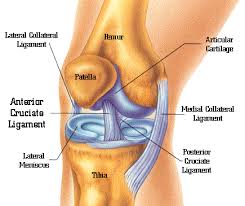
Even though it is still warm and sunny here in San Diego, we all are starting to think about when we are going skiing this year. The next question we should ask ourselves is… am I ready to go skiing this year? Skiing requires muscles and muscle groups that are used very little the rest of the year. If we don’t prepare, our risk for injury increases. As we all have heard before, most injuries occur toward the end of the day as people become fatigued and as daylight and conditions have deteriorated. But, we here at ProActive have seen our fair share of patients who were injured on the first run of the day as well.
Back in the 1970′s, ankle injuries were more common, resulting from soft, leather boots. The development of stiffer boots has transferred much of the force to the knee. Now the most common injury for skiers is knee injuries, while snowboarders more commonly injure their wrists and collar bones. The most common knee injury from skiing is the MCL (medial collateral ligament) injury. It often results from catching an edge or having the skis diverge, so that the foot is forced away from the body. This creates a distraction force on the inside of the knee. Fortunately, the MCL has a good blood supply, and can be treated non-operatively, with a period of bracing for 4-8 weeks, depending on the severity of the injury.
ACL (anterior cruciate ligament) injuries are also common skiing injuries. They are thought to occur from the forces created by the long lever arm of the ski that are transmitted to the knee ligaments. Commonly, the ACL is injured with a hyperextension mechanism. Recent boot and binding technology has reduced the rate of ACL injuries. In young, active individuals, the ACL injuries often require surgical reconstruction. Success rates from surgery are excellent, but require aggressive rehabilitation and six months of recovery time before one can return to skiing or other twisting or pivoting sports.
When should people start their physical preparations for ski season, especially if they are not a regular exerciser? Is it too late?…. it is not too late…… now is the time to get on a winter sports fitness program and build a base of conditioning. Generally, you don’t want to “ski yourself into shape”. So, the sooner you begin a conditioning program, the better off you’ll be on the slopes. Next week I will discuss what specific activities you should do to prepare yourself , when hitting the slopes, to increase strength and endurance and decrease risk for injury.

